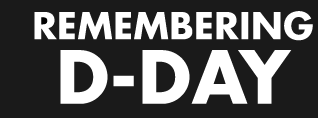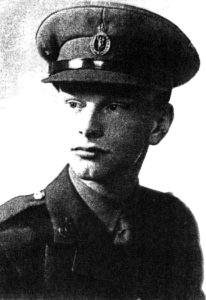So as to be able to choose ‘my line’, I volunteered in 1942 before I was called up and enlisted for the Royal Corps of Signals. I was commissioned in October 1943 and in November I was posted to 3rd Division Signals, then training near Inverness in preparation for the Normandy landings. Through the winter months we carried out numerous ‘wet’ landings in Burghead Bay, having embarked on LCTs on the ‘Black Isle’. I was 2 i/c of A Section (the main HQ radio section). At first I was not selected to go over on D-Day, but due to the officer in charge being called away and his replacement not having trained in the details of the landing, I was ordered to take his place.
In May we moved south to near Portsmouth and in due course went aboard LCTs at Newhaven on 4 June. I had two sub-sections, each with a radio in a handcart fitted with floats and fully waterproofed. When D-Day was postponed 24 hours, we were taken ashore to a camp for food but slept on deck.
We set sail on the evening of 5 June in a convoy of LCTs line astern between flag-flying floats marking the swept channel. The handcart teams were housed in the two bow compartments and soon suffered severe seasickness in spite of the ‘anti’ pills; those of us ‘midships’ were better off. The craft was loaded with tanks and under them, towed off behind them on landing, were floats loaded with ammunition.
I was invited onto the bridge by the naval lieutenant. Soon afterwards our craft rammed the one in front. Not content with this the rating at the wheel then steered us off line and out of the swept channel. The bosun was summoned from his bunk to take over and the rating was sent into the bows to watch for mines.
At dawn the whole invasion fleet was revealed around us, with much firing at the French coast and counter fire from the left flank by the enemy. Our LCT made land fall on SWORD beach exactly as predicted. It had a small barrage balloon attached to it. The rope of this was passed to one of our group to take ashore but almost immediately it dropped, pierced by shrapnel.
Meanwhile all the tanks had gone ashore and it was apparent that we were in deepish water, well out of our depth. The naval lieutenant was not keen to go in further as another craft near by had already disintegrated in an enormous explosion when hit by shell fire. A member of my section, a strong swimmer, volunteered to take a rope ashore and tie it to a burnt out tank. We and our handcarts then struggled ashore along the rope, which we then cast off.
We made our way inland along the narrow road shown on our maps, crowded with tanks and signed ‘minen’ with a skull and cross bones each side. We set up HQ in an orchard. Bark was soon flying off a tree beside us under a sniper’s bullets while we were sampling our tins of self-heating soup. This, and a report of enemy tanks counter-attacking, caused us to move. I accompanied the company commander on a recce in his jeep along the coast road. Seeing a German plane diving at us we stopped and jumped into a ditch, but luckily for us he had no ammunition left.
We located a suitable field near Hermanville into which HQ moved and remained there for some weeks, with our radio sets in surrounding fields, during the battle for Caen. One of my jobs was to set up communications at suitable observation posts for the General before he made an attack. I particularly remember watching the bombardment and subsequent tank attack to capture Lebisey wood north of Caen. On one occasion one of our section’s half-track vehicles took a wrong turning, south instead of north at a T-junction, and ended up with its tracks off on the mines at our front line. I set off on a motorbike with help in a captured truck to recover the codebooks and radios. On arrival at the scene we were not popular as we were in sight of the enemy who brought down mortar fire on the front-line troops there and we sheltered in their slit trench for some time. On leaving it transpired that the captured lorry could not be restarted, so it was also abandoned on the front line and its crew had to walk the two miles back to HQ.
Shelling was a daily occurrence, and one dark night we suffered severe bombing that set the woods on fire and burnt out the telephone exchange and cipher trucks. I often slept under a lorry while enemy parachute flares illuminated the area around us. It is hard to put into words how we all coped with fear and getting on with the job in hand. Each did so in their own way. Writing this it could appear that it was all a bit of ‘fun’. Only those who were there know the whole truth of seeing comrades wounded and wondering if we would see out the day ourselves.
We crossed the River Orne towards Troarn, where the mosquito bites brought up large lumps and caused us nearly as much trouble as the enemy. While on a recce back towards Hermanville I contrived to run my motorbike into a shell hole on the road alongside which the gliders had landed some weeks before. After a day or so, my damaged ankle refused to heal and I returned to the UK. Following some weeks recovering in hospital, I was posted to India.

